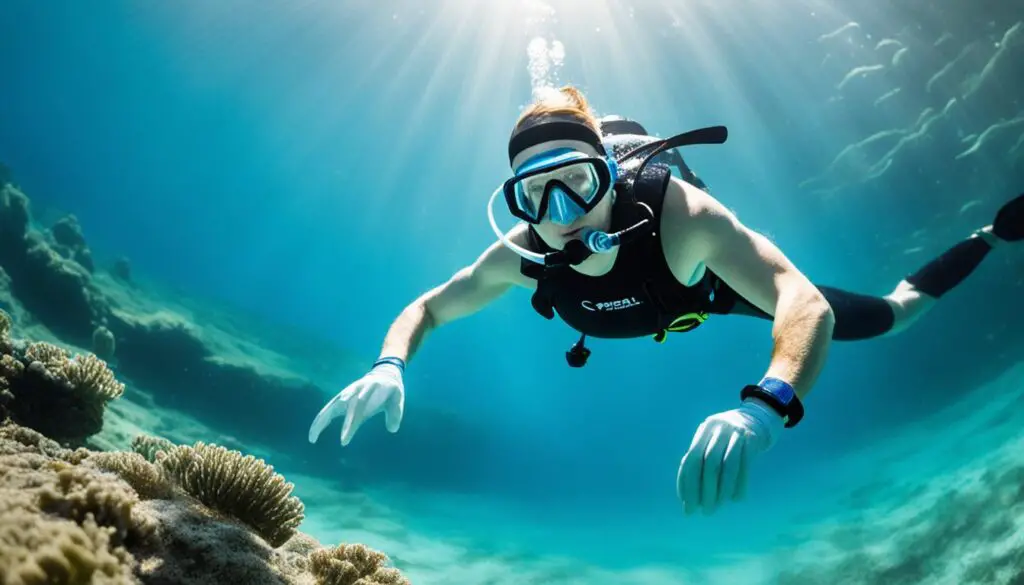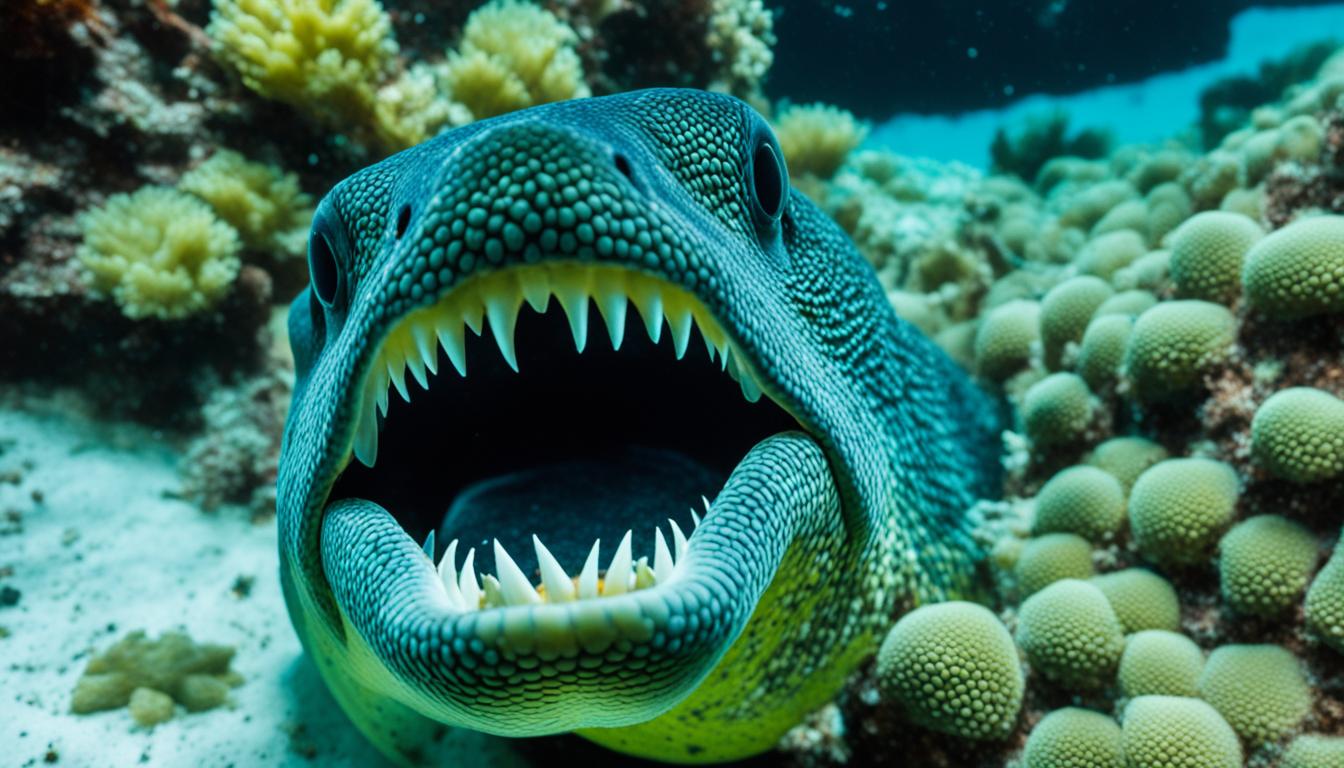Moray eels have long, snake-like bodies and sharp teeth, making them seem both scary and intriguing. You might ask, “Are moray eels dangerous to humans?” These creatures live in coral reefs and rocky places. They can get aggressive if they feel threatened. But, they don’t bite humans often.
However, if you disturb their space, they might bite. Luckily, moray eels aren’t venomous, unlike some ocean creatures. But, their bites can still cause serious injuries and health issues. It’s important to know how to stay safe around them.
Understanding Moray Eel Behavior
Moray eels live fascinating lives under the sea. They spend their days hidden in rocky places and hunt at night. These eels are usually not aggressive towards people unless they feel threatened. Their bodies can change color to hide, making them hard to see for divers and snorkelers. Knowing how they behave helps keep them safe and improves our interactions with them.
Factors That Influence Moray Eel Aggression
Many things can make moray eels aggressive. For example, changes in their environment can make them defensive. If people get too close or disturb their hiding spots, they might feel threatened. Quick movements from humans can also make them snap.
Knowing what triggers their aggression helps avoid fights and keeps them safe. This is important for those exploring the underwater world.
Common Misconceptions About Moray Eels
Many people wrongly think moray eels are dangerous and aggressive. They believe their sharp teeth mean they are always looking for a fight. But, these eels don’t usually attack humans. Learning the truth about moray eels helps us appreciate them more and stay safe while diving or snorkeling.
Are moray eels dangerous to humans?
Moray eels can be dangerous to humans, especially when diving or snorkeling. They might bite if they feel threatened or trapped. These bites can cause injuries, from mild to severe.
Symptoms of Moray Eel Bites
Knowing the signs of a moray eel bite is key. You might feel:
- Immediate and severe pain
- Visible bleeding and cut markings
- Swelling around the affected area
- Possible nerve damage that limits movement
Moray eels have sharp teeth that can cause a lot of harm. It’s important to be aware of these risks.
Immediate First Aid for Moray Eel Bites
Quick action is crucial after a moray eel bite. Here’s what to do:
- Thoroughly wash the wound with soap and clean water
- Apply pressure to stop any bleeding
- Cover the wound with a sterile bandage
- Manage pain with over-the-counter medications
Always get medical help to check for any serious injuries from moray eel bites.
Long-Term Effects of Moray Eel Bites
Long-term effects from moray eel bites depend on the injury’s severity and location. You might face:
- Scarring on the skin
- Tissue loss that affects appearance or function
- Infections that could lead to serious issues, like septicemia
- Potential need for surgical intervention if bones or muscles are damaged
Quick action after a moray eel bite helps with immediate issues and can prevent long-term problems.
Moray Eel Venom and Toxins
It’s important to understand moray eel venom and toxins if you’re around these creatures. Moray eels don’t have venomous bites like some others. But, their mucus has toxins that can affect human health if they bite you.
Understanding Mucus Toxins and Their Effects
The toxins in moray eel mucus can make bites more painful and swollen. They can also cause blood clumping, which is dangerous. If these toxins get into your blood, you could get a serious infection.
This shows why it’s key to know how moray eels behave before you meet them. It’s especially important for divers and snorkelers who might run into moray eels.
Types of Moray Eels and Their Associated Risks
Not all moray eels are the same when it comes to danger to humans. The dragon moray eel is known for being aggressive and might bite if it feels threatened. On the other hand, ribbon moray eels are usually less aggressive but can bite if they feel cornered.
Knowing these differences can help you stay safe around them. If you’re going to be in their area, keep these facts in mind for a safe visit.
Preventing Moray Eel Encounters
It’s important to know how to avoid moray eels if you dive or snorkel in their home waters. Knowing where they live and what they do can help you stay out of their way. Keep a safe distance from rocky reefs and hidden spots to keep safe from moray eels.
Safe Practices While Diving or Snorkeling
When diving in places with moray eels, follow these safe tips to make your dive better and safer. Here are some guidelines:
- Avoid sudden movements in the water to prevent startling moray eels.
- Do not reach into crevices where eels could be hiding.
- Stay visually aware of your surroundings to spot any potential threats.
- Familiarize yourself with the specific area and its inhabitants.
Following these safety tips can greatly lower the chance of bad encounters with moray eels.
Guidelines for Handling Moray Eels in Aquariums
If you keep moray eels in an aquarium, it’s key to handle them safely for your safety and theirs. Here are some tips:
- Avoid hand-feeding moray eels, as this may provoke aggression.
- Use long-handled tools for tank maintenance to prevent bites.
- Create an environment that meets the specific needs of moray eels to reduce stress and aggressive behavior.
Following these practices helps keep you and the moray eels safe and healthy.

Comparing Moray Eels to Other Dangerous Fish
Learning about moray eels helps us see how they stack up against other dangerous sea creatures. Each marine animal has its own risks for humans. Moray eels, with their scary looks and strong bites, can hurt people. But, they’re not the only ones to watch out for.
Pufferfish can puff up and are full of toxins that could be deadly. Lionfish have venomous spines that hurt a lot if they get through your skin. These fish show us that danger comes in many forms in the ocean.
Moray eels also have special mucus that protects them. This mucus keeps away parasites and helps them heal. Some fish, like triggerfish, can get aggressive when they feel their home is being threatened.
Here’s a table that highlights the main risks and features of moray eels and other dangerous fish:
| Fish Species | Primary Threat | Method of Attack | Unique Features |
|---|---|---|---|
| Moray Eel | Bite | Defensive Bite | High mucus production, aggressive when threatened |
| Pufferfish | Toxin | Ingestion | Contains tetrodotoxin, deadly when consumed |
| Lionfish | Venom | Puncture from spines | Beautiful yet venomous spines |
| Triggerfish | Bite | Defensive Bite | Known for aggressive territorial behavior |
Dealing with different fish safely is key. Knowing about their dangers helps us respect the ocean and its creatures. This knowledge is crucial for anyone who loves the sea.
The Importance of Respecting Marine Life
Understanding the importance of respecting marine life is key to keeping our oceans healthy. It’s important to know how creatures like moray eels behave. These fascinating animals play a big role in their ecosystems, helping to keep everything in balance.
Learning about moray eel behavior helps you appreciate them more. This knowledge shows why we need to protect them. When we respect marine life, we protect their homes, which are crucial for their survival and the health of the ocean.
Living with these unique creatures is easier when we know how they behave. Keeping a safe distance lets you enjoy watching moray eels without harming their home. By doing this, you help ensure a future where all marine life thrives, showing the value of respecting marine life.
FAQ
Are moray eels dangerous to humans?
Moray eels have strong jaws and sharp teeth, but they usually don’t attack humans unless they feel threatened. Knowing how they act can help keep you safe when you meet them.
What are the symptoms of a moray eel bite?
A bite can cause anything from small cuts to serious injuries. You might feel pain, see bleeding, swelling, or even nerve damage. It’s important to get medical help right away.
How should I treat a moray eel bite?
First, clean the wound with soap and water. Press on it to stop bleeding. Then, cover it with a clean bandage. Always get medical help quickly to prevent more problems.
Do moray eels have venom?
Moray eels don’t have venom in their bites. But, they do have toxins in their mucus. These can make a bite worse and increase the chance of infection.
How can I prevent moray eel encounters while diving?
Keep a safe distance from rocky reefs and move slowly. Know where you are and don’t disturb their homes.
What should I know about handling moray eels in aquariums?
Don’t feed moray eels by hand to avoid getting bitten. Use long tools for aquarium care to keep safe.
How do moray eels compare to other dangerous fish species?
Moray eels can bite hard but they’re not venomous like some other fish, like pufferfish or lionfish. Each fish has its own dangers and should be treated with care.
Why is it important to respect marine life such as moray eels?
Respecting marine life helps keep the ocean healthy and supports conservation. Understanding moray eels helps us interact with them safely and appreciate the ocean’s diversity.







